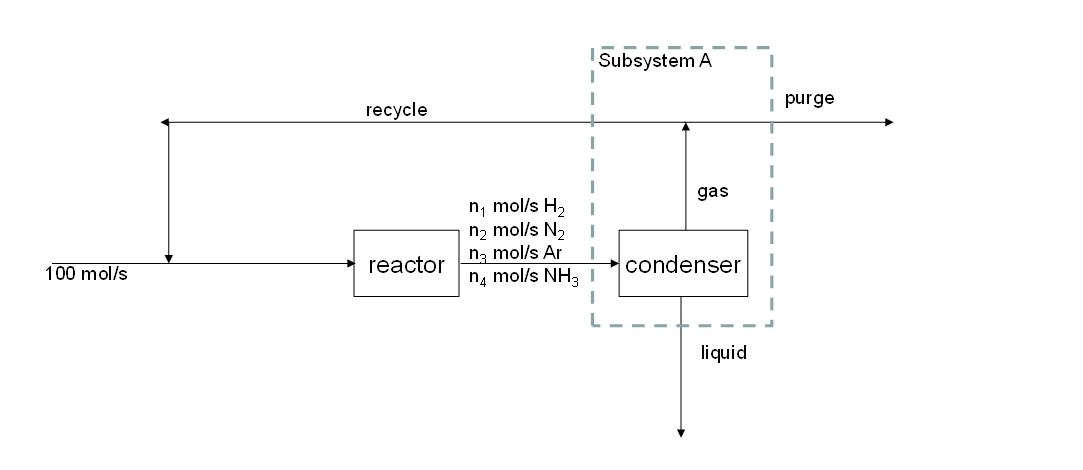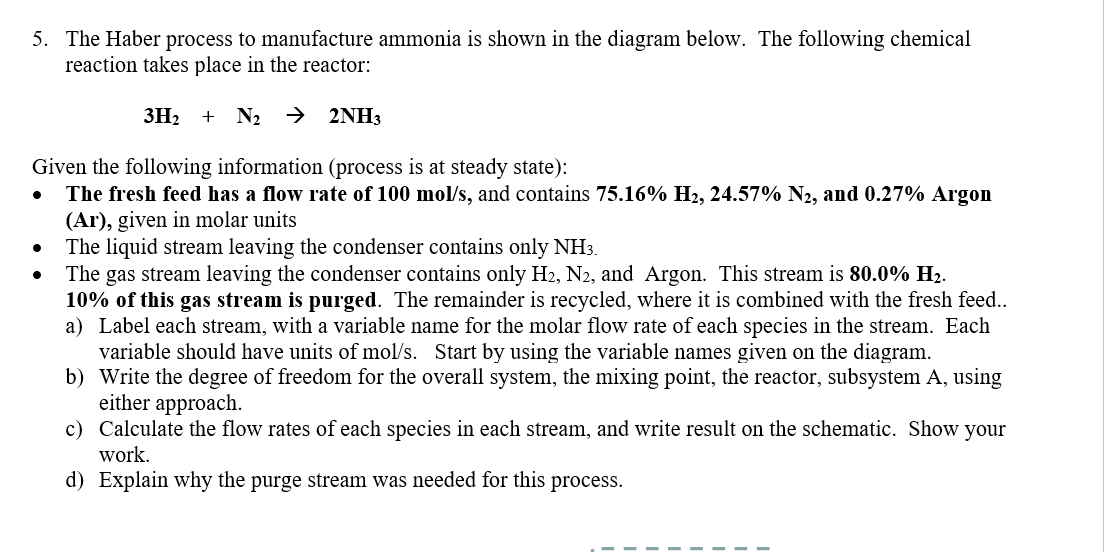5. The Haber process to manufacture ammonia is shown in the diagram below. The following chemical reaction takes place in the reactor: 3H₂ + N₂ → 2NH3 Given the following information (process is at steady state): The fresh feed has a flow rate of 100 mol/s, and contains 75.16% H₂, 24.57% N₂, and 0.27% Argon (Ar), given in molar units The liquid stream leaving the condenser contains only NH3. The gas stream leaving the condenser contains only H2, N2, and Argon. This stream is 80.0% H₂. 10% of this gas stream is purged. The remainder is recycled, where it is combined with the fresh feed.. a) Label each stream, with a variable name for the molar flow rate of each species in the stream. Each variable should have units of mol/s. Start by using the variable names given on the diagram. b) Write the degree of freedom for the overall system, the mixing point, the reactor, subsystem A, using either approach. c) Calculate the flow rates of each species in each stream, and write result on the schematic. Show your work. d) Explain why the purge stream was needed for this process.
5. The Haber process to manufacture ammonia is shown in the diagram below. The following chemical reaction takes place in the reactor: 3H₂ + N₂ → 2NH3 Given the following information (process is at steady state): The fresh feed has a flow rate of 100 mol/s, and contains 75.16% H₂, 24.57% N₂, and 0.27% Argon (Ar), given in molar units The liquid stream leaving the condenser contains only NH3. The gas stream leaving the condenser contains only H2, N2, and Argon. This stream is 80.0% H₂. 10% of this gas stream is purged. The remainder is recycled, where it is combined with the fresh feed.. a) Label each stream, with a variable name for the molar flow rate of each species in the stream. Each variable should have units of mol/s. Start by using the variable names given on the diagram. b) Write the degree of freedom for the overall system, the mixing point, the reactor, subsystem A, using either approach. c) Calculate the flow rates of each species in each stream, and write result on the schematic. Show your work. d) Explain why the purge stream was needed for this process.
Introduction to Chemical Engineering Thermodynamics
8th Edition
ISBN:9781259696527
Author:J.M. Smith Termodinamica en ingenieria quimica, Hendrick C Van Ness, Michael Abbott, Mark Swihart
Publisher:J.M. Smith Termodinamica en ingenieria quimica, Hendrick C Van Ness, Michael Abbott, Mark Swihart
Chapter1: Introduction
Section: Chapter Questions
Problem 1.1P
Related questions
Question
complete part D only

Transcribed Image Text:ܕܒ 1
100 mol/s
recycle
reactor
n₁ mol/s H₂
n₂ mol/s N₂ I
na mol/s Ar I
n4 mol/s NH3 |
Subsystem A
gas
condenser
liquid
purge

Transcribed Image Text:5. The Haber process to manufacture ammonia is shown in the diagram below. The following chemical
reaction takes place in the reactor:
3H₂ + N₂
→ 2NH3
Given the following information (process is at steady state):
The fresh feed has a flow rate of 100 mol/s, and contains 75.16% H2, 24.57% N2, and 0.27% Argon
(Ar), given in molar units
The liquid stream leaving the condenser contains only NH3.
The gas stream leaving the condenser contains only H2, N2, and Argon. This stream is 80.0% H₂.
10% of this gas stream is purged. The remainder is recycled, where it is combined with the fresh feed..
a) Label each stream, with a variable name for the molar flow rate of each species in the stream. Each
variable should have units of mol/s. Start by using the variable names given on the diagram.
b) Write the degree of freedom for the overall system, the mixing point, the reactor, subsystem A, using
either approach.
c)
Calculate the flow rates of each species in each stream, and write result on the schematic. Show your
work.
d) Explain why the purge stream was needed for this process.
Expert Solution
This question has been solved!
Explore an expertly crafted, step-by-step solution for a thorough understanding of key concepts.
Step by step
Solved in 2 steps

Recommended textbooks for you

Introduction to Chemical Engineering Thermodynami…
Chemical Engineering
ISBN:
9781259696527
Author:
J.M. Smith Termodinamica en ingenieria quimica, Hendrick C Van Ness, Michael Abbott, Mark Swihart
Publisher:
McGraw-Hill Education

Elementary Principles of Chemical Processes, Bind…
Chemical Engineering
ISBN:
9781118431221
Author:
Richard M. Felder, Ronald W. Rousseau, Lisa G. Bullard
Publisher:
WILEY

Elements of Chemical Reaction Engineering (5th Ed…
Chemical Engineering
ISBN:
9780133887518
Author:
H. Scott Fogler
Publisher:
Prentice Hall

Introduction to Chemical Engineering Thermodynami…
Chemical Engineering
ISBN:
9781259696527
Author:
J.M. Smith Termodinamica en ingenieria quimica, Hendrick C Van Ness, Michael Abbott, Mark Swihart
Publisher:
McGraw-Hill Education

Elementary Principles of Chemical Processes, Bind…
Chemical Engineering
ISBN:
9781118431221
Author:
Richard M. Felder, Ronald W. Rousseau, Lisa G. Bullard
Publisher:
WILEY

Elements of Chemical Reaction Engineering (5th Ed…
Chemical Engineering
ISBN:
9780133887518
Author:
H. Scott Fogler
Publisher:
Prentice Hall


Industrial Plastics: Theory and Applications
Chemical Engineering
ISBN:
9781285061238
Author:
Lokensgard, Erik
Publisher:
Delmar Cengage Learning

Unit Operations of Chemical Engineering
Chemical Engineering
ISBN:
9780072848236
Author:
Warren McCabe, Julian C. Smith, Peter Harriott
Publisher:
McGraw-Hill Companies, The